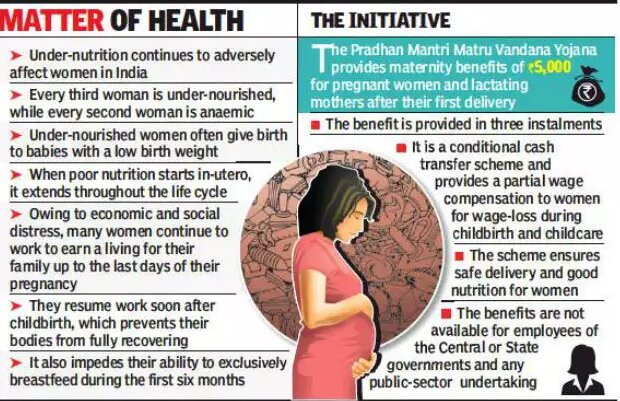Pradhan Mantri Matru Vandana Yojana
Why in News
Recently, the government's maternity benefit scheme, or Pradhan Mantri Matru Vandana Yojana (PMMVY), has crossed 1.75 crore eligible women till the financial year 2020.
- A total sum of Rs. 5,931.95 crore was paid to 1.75 crore eligible beneficiaries between financial year 2018 and 2020.
Key Points
- About:

- PMMVY is a maternity benefit programme being implemented in all districts of the country with effect from 1st January, 2017.
- It is a centrally sponsored scheme being executed by the Ministry of Women and Child Development.
- Direct Benefit Transfer Scheme:
- Cash benefits are provided to pregnant women in their bank account directly to meet enhanced nutritional needs and partially compensate for wage loss.
- Target Beneficiaries:
- All Pregnant Women and Lactating Mothers (PW&LM), excluding those who are in regular employment with the Central Government or the State Governments or PSUs or those who are in receipt of similar benefits under any law for the time being in force.
- All eligible Pregnant Women and Lactating Mothers who have their pregnancy on or after 1st January 2017 for the first child in the family.
- Benefits under the Scheme:
- Beneficiaries receive a cash benefit of Rs. 5,000 in three installments on fulfilling the following conditions:
- Early registration of pregnancy
- Ante-natal check-up
- Registration of the birth of the child and completion of first cycle of vaccination for the first living child of the family.
- The eligible beneficiaries also receive cash incentive under Janani Suraksha Yojana (JSY). Thus, on an average, a woman gets Rs. 6,000.
- Beneficiaries receive a cash benefit of Rs. 5,000 in three installments on fulfilling the following conditions:
- Distinctive Feature:
- Implementation of the scheme is closely monitored by the central and state governments through the Pradhan Mantri Matru Vandana Yojana - Common Application Software (PMMVY-CAS).
- PMMVY-CAS is a web based software application that enables tracking the status of each beneficiary under the scheme, resulting in expedited, accountable and better grievance redressal.
Janani Suraksha Yojana
- About:
- It is a 100% centrally sponsored scheme which is being implemented with the objective of reducing maternal and infant mortality by promoting institutional delivery among pregnant women.
- As per the data of National Family Health Survey-5:
- Infant and child mortality rates across most Indian states have declined.
- Bihar registered the highest prevalence of neonatal mortality rate (NMR-34), infant mortality rate (IMR-47), and under-five mortality rate (U5MR-56) across 22 surveyed states and Union territories while Kerala reported the lowest death rates.
- Infant and child mortality rates across most Indian states have declined.
- The Maternal Mortality Ratio (MMR) in India has declined to 113 (per 1,00,000 live births) in 2016-18 from 122 in 2015-17 and 130 in 2014-2016, according to the special bulletin on Maternal Mortality in India 2016-18, released by the Office of the Registrar General's Sample Registration System (SRS).
- The target 3.1 of Sustainable Development Goals (SDGs) set by the United Nations aims at reducing the global maternal mortality ratio to less than 70 per 1,00,000 live births.
- As per the data of National Family Health Survey-5:
- Basically, it is a safe motherhood intervention under the National Health Mission (NHM).
- It is a 100% centrally sponsored scheme which is being implemented with the objective of reducing maternal and infant mortality by promoting institutional delivery among pregnant women.
- Benefit:
- Under the JSY, eligible pregnant women are entitled for cash assistance irrespective of the age of mother and number of children, for giving birth in a government or accredited private health facility.
- The scheme also provides performance based incentives to women health volunteers known as Accredited Social Health Activist (ASHA) for promoting institutional delivery among pregnant women.
- Other Schemes Focussing on Nutritional and Health Aspects of Women:
- Indira Gandhi Matritva Sahyog Yojna (IGMSY):
- The scheme aims to contribute to a better enabling environment by providing cash incentives for improved health and nutrition to pregnant and lactating mothers.
- It is being implemented by the Ministry of Women and Child Development.
- Kudumbashree in Kerala:
- It was launched in Kerala in 1998 to wipe out absolute poverty through community action. It is the largest women empowering project in the country. It has three components i.e., microcredit, entrepreneurship and empowerment.
- Poshan Abhiyaan:
- Launched in March 2018, the goal of Poshan Abhiyaan is to achieve improvement in the nutritional status of Children (0-6 years) and Pregnant Women and Lactating Mothers in a time-bound manner.
- Integrated Child Development Services (ICDS) Scheme:
- The scheme provides specific interventions targeted towards the vulnerable groups including children below 6 years and women.
- It is being implemented by the Ministry of Women and Child Development.
- Indira Gandhi Matritva Sahyog Yojna (IGMSY):